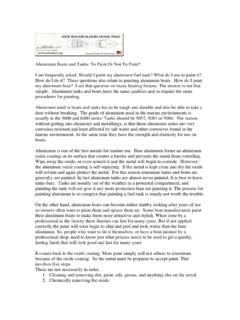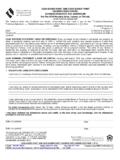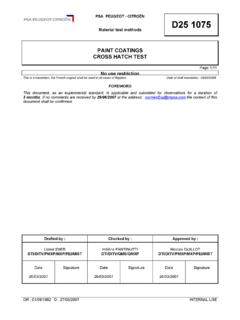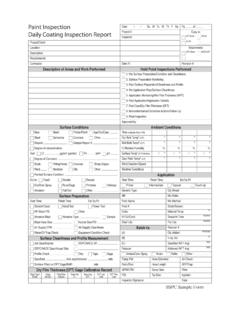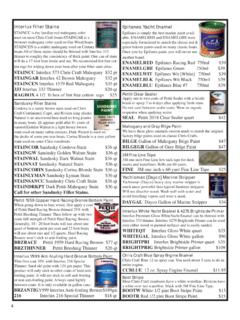Transcription of SMART paint spraying
1 Health and Safety ExecutiveSMART paint sprayingHow to control health and safety risksPage 1 of 9 INDG473, published 2014 IntroductionWho is this leaflet for?This guide is for SMART (small and medium area repair technique) repair sprayers using isocyanate-based and other paints and who generally have no fixed place of work. It is also useful for franchisees, managers and operators in motor vehicle repair bodyshops, who manage, carry out or commission SMART type repair. It replaces the previous version, published as Motor vehicle repair: Good practice for SMART sprayers (WEB33).
2 What is it about?It describes how to control risks to health and safety from paint spraying in SMART repairs. These procedures are normally sufficient to achieve adequate control for SMART spraying techniques, as defined under the Control of Substances Hazardous to Health Regulations 2002 (COSHH). Paints include surface coatings that are dried or cured by infrared or UV light, chemical hardeners or other means. Some of the paints and lacquers used in SMART repairs contain isocyanates. There is a chance of developing occupational asthma when working with isocyanate-based paints/lacquers, and also of developing dermatitis from these and other reactive products.
3 If you become affected you will probably never be able to work with these products can it help me?This leaflet can help you with your COSHH assessment. That assessment may show that different controls apply in your circumstances. You will need to record any such conclusions unless you are self-employed or an employer with five employees or fewer, although it is still useful so you can review it at a later date, eg if something changes. This publication supports existing guidance on the subject.
4 See HSE s motor vehicle repair site ( ) and particularly the publications Safety in isocyanate paint spraying1 and Isocyanate paint spraying : Safely managing spray booths and rooms2 for further details. What are the key precautions for SMART spraying ? Wear suitable respiratory protective equipment. Keep other people away from spray mist. Health and Safety ExecutiveSMART paint spraying Page 2 of 9 Figure 1 Well-defined external area ready for SMART sprayingWhat is SMART spraying ? SMART spraying is the spray application of a surface coating to parts of motor vehicles as part of a repair, usually outside the customer s house or place of work.
5 The parts coated should not extend to a complete panel or , SMART spraying is by: mini-spray gun or airbrush, normally having an inlet pressure up to 2 bar, delivering a volume of air much less than 150 l/min and a fluid flow well below 100 g/min; or pre-packaged aerosol spray can. The quantity of paint sprayed is unlikely to exceed 25 ml per coat. The time spent spraying paint is unlikely to exceed 1 minute per coat, although the spray job may take a few minutes. Bodyshops are now using similar techniques to SMART spraying to decrease throughput times in their workshops.
6 If greater quantities are to be used (than specified above) or spraying time is likely to be longer than a few minutes in total, then further control measures will be required to achieve adequate control (eg spraying in a suitable spray booth/room). The exact definition of what is or is not SMART spraying is not important as long as the exposure to the hazardous substances is well and Safety ExecutiveSMART paint spraying Page 3 of 9 Figure 2 Typical SMART repair paint hazards and risks Conventional paint spraying products Conventional spraying products are solvent-based, commonly known as cellulose paints.
7 The health risks from spraying typically include irritation of eyes, nose and throat, and mild reversible effects on the body, which usually do not cause permanent damage in the small quantities commonly SMART spraying products SMART spraying products are reactive one-pack products, or two-pack products that require mixing before use. The products may be solvent-based or water-based. The health risks depend on the chemistry, but for reactive products: isocyanate-based products (including water-based isocyanate products) may cause asthma and dermatitis; UV-curable products may cause dermatitis (and may contain isocyanate); other products (eg acid-cured) may cause effects at least as serious as solvent-based products, including irritation of eyes, nose and throat, and mild reversible effects on the body.
8 Table 1 Some common misconceptions about isocyanates FalseTrueIsocyanates contain cyanide that poisons you. Isocyanate doesn t contain cyanide. Isocyanates cause cancer. Isocyanates cause asthma. Isocyanates get into the body through thin skin, eg around the eyes. Isocyanates get into the body by breathing in mists. I m safe there s no history of asthma in my can cause asthma in anyone who is exposed. Smoking makes developing asthma more paint doesn t contain isocyanate, so it is perfectly paints are dangerous for supply.
9 Read the safety data sheet!Health and Safety ExecutiveSMART paint spraying Page 4 of 9 Storage Keep the quantities of stored paint products to a minimum. If other SMART products contain peroxides (eg activators for polyester resins used with fillers or fibreglass), these must be kept apart and stored in a sealed metal container. Controlling risks Training and competence SMART sprayers should be trained to: understand the hazards and risks, and how to control them; recognise the signs of ill health, and what to do about them; use equipment, RPE and products safely; maintain equipment and RPE; decontaminate and dispose of waste properly.
10 SMART sprayers should be able to provide evidence of training from their franchiser, product supplier or professional training provider. Respiratory protective equipment (RPE) The sprayer needs to ensure that suitable RPE and other personal protective equipment (PPE) is worn, including when SMART spraying is carried out externally. When SMART spraying with reactive products, the sprayer will also need skin protection. Some reactive products may contain isocyanates. If this is the case, RPE needs to be air-fed with an assigned protection factor (APF) of 20 or higher, eg LDM2 air-fed half mask or LDH3 air-fed visor.










